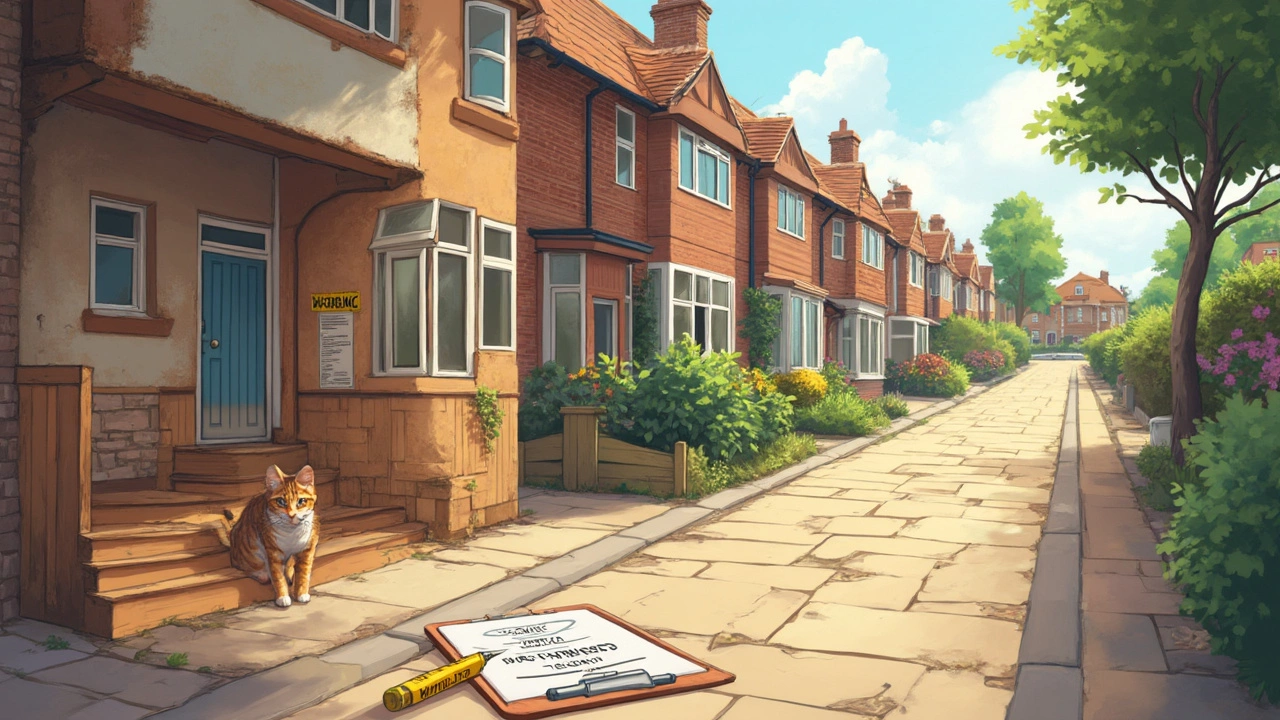You notice the floor in your living room isn't flat anymore. Maybe things are starting to roll or shift, or furniture wobbles. A lot of people panic, thinking, “Will my insurance help pay for this?”
Here’s a hard truth: most standard home insurance plans don’t jump at the chance to pay for sagging floors, especially if it’s from regular wear and tear or settling. Insurance companies usually only step in if something sudden happens—like a burst pipe under the floor or a tree crashing through your living room. If your floors are drooping because your house is getting older or the foundation is tired, getting coverage gets way trickier.
The cause matters—a lot. If water damage from a covered event caused the sag, you might have a shot at a successful claim. But if it's soil shifting over years, termites chewing silently, or ignoring a decades-old drainage problem, your policy likely says tough luck. Want to avoid surprises? Start by reading your policy’s “exclusions” section. That part is never fun, but it’ll tell you exactly what your insurer is off the hook for.
- Why Floors Sag and What It Means
- What Home Insurance Typically Covers
- Common Scenarios: Will Your Claim Be Denied?
- Concrete Tips to Boost Your Chances
Why Floors Sag and What It Means
So, what causes a sagging floor in the first place? The short answer: it’s usually not something sudden. Floors often start to sink or droop because of slow-moving problems under your house. This isn’t just about creaky boards—it’s about what’s actually supporting them under the surface.
The biggest offenders are foundation issues. Homes with crawl spaces or basements are at higher risk because moisture, weak soil, or shoddy construction can all weaken supports over time. According to the International Association of Certified Home Inspectors (InterNACHI), “The most common cause for sagging floors is the weakening or shifting of support beams or joists due to moisture intrusion, pest activity, or settling soil.”
“The most common cause for sagging floors is the weakening or shifting of support beams or joists due to moisture intrusion, pest activity, or settling soil.” — InterNACHI
Let’s break down the main reasons:
- Sagging floors from water damage: Pipes leaking or groundwater sneaking into your crawl space can rot wood beams. Mold eats away at them, and before you know it, the floor above isn’t flat anymore.
- Shifting soil: Certain soils, like clay, expand and shrink with moisture. Over years, this movement messes with your foundation and supporting structures, causing the floors upstairs to bow or dip.
- Subpar support: Sometimes, builders just didn’t install strong enough beams. Cheap lumber or improper spacing can come back to haunt homeowners decades later.
- Pests: Termites and carpenter ants aren’t just gross—they love chewing on beams, making floors unsafe and droopy.
This isn’t just cosmetic. Sagging floors could hint at bigger risks: structural weakness, mold, or even tripping hazards for you and your family. If it’s getting worse or you spot signs like cracked drywall or doors that won’t close, get a foundation specialist in sooner rather than later.
| Main Cause | Warning Sign | Potential Fix |
|---|---|---|
| Moisture Damage | Musty smell, visible mold, soft spots | Repair leaks, replace damaged wood, add vapor barrier |
| Soil Movement | Cracks in walls, uneven doors, floor dips | Foundation repair, install piers, improve drainage |
| Termite/Pest Activity | Sawdust piles, hollow-sounding wood | Pest control, replace support beams |
| Poor Construction | Chronic sagging, visible beam bowing | Retrofit supports, install additional beams |
If you catch problems early, repairs are easier—and cheaper. Watch for warning signs and act fast to avoid bigger trouble down the road.
What Home Insurance Typically Covers
First off, most home insurance policies follow the same playbook. They’re designed for sudden, accidental damage—not slow problems. That means if an earthquake or flood wrecks your foundation or floors, your regular policy probably won’t help because those disasters are almost always excluded. You need special coverage for those.
So, what’s actually covered? Here’s the core rule: your insurer usually steps in if sagging floors are caused by unexpected, covered events. Think a burst water heater that soaks the floor, a kitchen fire that weakens supports, or a tree crashing into your house. These are the classic “perils” insurance likes to pay for:
- Fire and smoke damage
- Sudden water damage (like a burst pipe—but not slow leaks)
- Collapse from weight of ice or snow
- Wind or hail (if they cause direct structural damage)
- Impact from vehicles or falling objects (think tree, not termites)
But if the floor trouble comes from old age, poor upkeep, termites, dry rot, or foundation settling over the years, you’re out of luck. Insurance adjusters are trained to sniff out long-term problems. And yes, they look for any sign the damage wasn’t sudden.
| Covered | Usually Not Covered |
|---|---|
| Burst pipe causing collapse | Slow foundation settling |
| Fire or smoke damage | Termite or pest damage |
| Tree falls during a storm | Wear and tear/old age |
| Vehicle impact | Dry rot or neglect |
If you’re unsure, call your insurer and ask for their typical list of exclusions. Some companies post these online. Also, consider an add-on (called an “endorsement” or “rider”) for coverage against earthquakes or floods if you live in risky areas. It costs extra—but can save you thousands if disaster hits.

Common Scenarios: Will Your Claim Be Denied?
Most people don’t find out what their policy covers until trouble hits. So, what happens in real life when you report sagging floors to your insurance company? Odds are, they're not just going to write you a check. Here's how different causes play out:
- Normal settling and aging: If your floors sag because your house is getting older or materials are wearing out, expect a straight denial. Insurers call this "maintenance issues"—you’re on your own.
- Water damage from a covered event: Say a pipe bursts or there’s sudden water from a covered plumbing disaster. If you act fast and document it, some companies will help pay for the repairs to the floor itself but not usually the underlying foundation.
- Flooding: Floods from outside (storm, river, etc.) rarely get covered by regular home insurance. You’d need separate flood insurance for that, which a lot of people don’t have until it’s too late.
- Termite or pest damage: Damage caused by critters is almost always excluded. You’re expected to prevent this before it gets bad.
- Sudden foundation failure: If the ground shifts fast (like from an earthquake), regular home insurance won’t pay unless you bought a separate earthquake policy.
It’s not just what happened, but how you respond. Delaying repairs or ignoring signs can hurt your claim, even if your situation started out as a covered event.
Here’s a quick visual summary of what typically happens when you file a claim:
| Scenario | Usually Covered? | Notes |
|---|---|---|
| Slow settling with age | No | Seen as maintenance |
| Sudden pipe burst | Sometimes | Depends on speed of response and extent of damage |
| Storm flooding | No (unless flood policy) | Regular policies exclude flood |
| Termite damage | No | Considered preventable |
| Earthquake | No (unless earthquake policy) | Separate coverage required |
Bottom line: if you think you’ve got a fighting chance for coverage, snap a bunch of photos, document everything, and call your agent before you touch anything. Sometimes, being organized and upfront can tip the decision in your favor—at least a little bit.
Concrete Tips to Boost Your Chances
If you’re hoping to get insurance to pay for those sagging floors, you need a strategy. Companies aren’t in the business of handing out checks unless you give them no choice. Here’s where you can help your own case:
- Document Everything: Snap photos from different angles as soon as you notice the problem. Get close-ups and wide shots. Keep these on your phone and email them to yourself for good measure.
- Find the Source: Figure out what actually caused your floor to sag. Insurance adjusters want proof. If it’s a burst pipe or a sudden leak, grab a copy of the plumber’s report. If it’s termites, hang onto the pest control invoice.
- Act Fast: File your claim ASAP after finding the damage. Some policies have strict time limits, and delays give insurance more wiggle room to say you didn’t maintain your property.
- Professional Inspection: Pay an expert to write up a detailed explanation of what’s gone wrong. This report can make or break your claim. Foundation specialists around the US usually charge $250–$500 for this, but it’s worth it if it helps tilt the odds.
- Don’t Do Patch Jobs: Temporary fixes look like neglect. Wait for the adjuster before you make any major repairs, unless it’s an emergency to stop more damage.
Insurance companies look for reasons to decline claims. Their top reasons are all about the cause—if they say it's "maintenance issues" or "old age," you're usually out of luck. Below is a handy table showing the claim approval odds based on common causes of floor sagging:
| Cause of Sagging Floor | Chance Insurance Pays |
|---|---|
| Sudden Water Damage (burst pipe, flood) | High (60-75%) |
| Termite Damage | Low (10-25%) |
| Regular Foundation Settlement | Very Low (under 10%) |
| Weather Event (like a fallen tree, tornado) | Medium to High (50-80%) |
| Neglected Maintenance/Old Age | Almost None |
If you do get denied, don’t just shrug. Ask your agent to show you the exact rule in your policy. Sometimes you can appeal or get a different inspector. And if you live in an area with shifting soil (think parts of Texas, Oklahoma, or Louisiana), ask your insurer about adding a special foundation rider, which can sometimes be tacked onto your policy for peace of mind.







